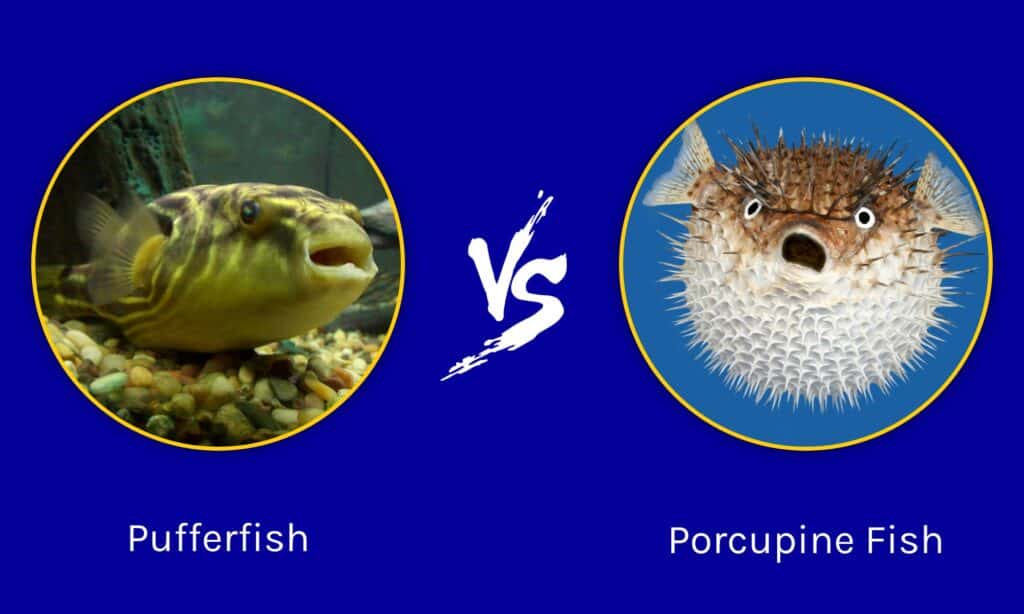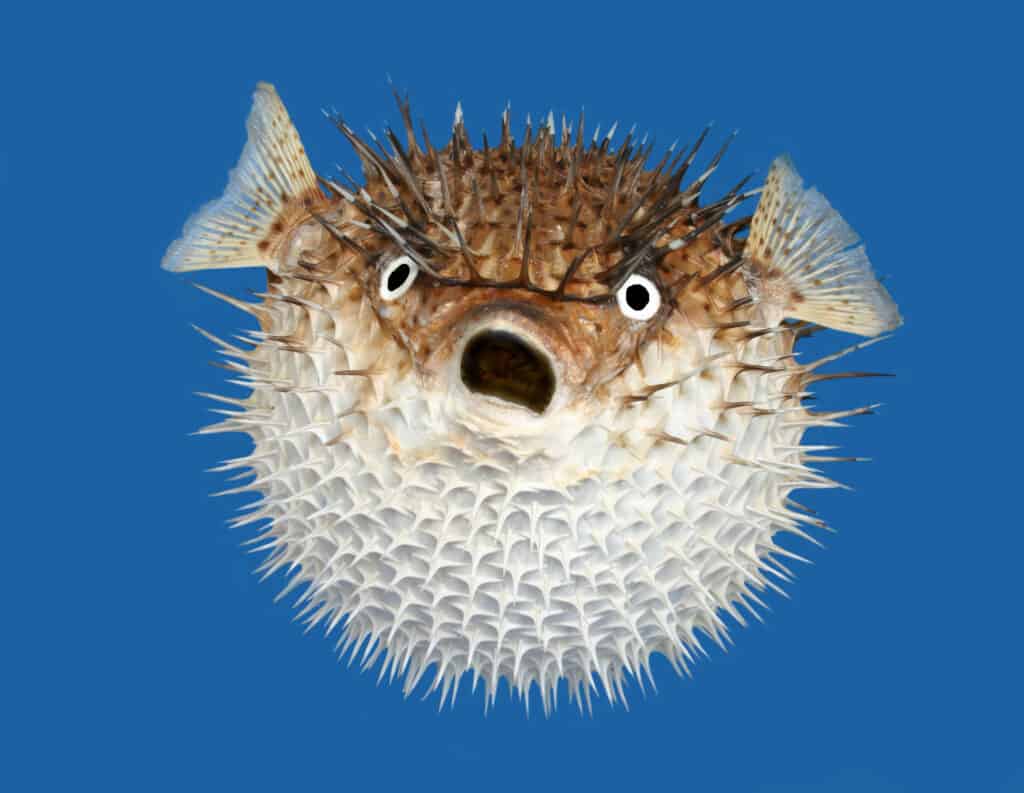The pufferfish and the porcupine fish are both animals of the large phylum Chordata. Not to be confused with the porcupine, the porcupine fish belongs to the Diodontidae family while the pufferfish belongs to the Tetraodontidae family. Both animals have other individual differences and peculiarities, which we’ll be exploring in this article.
Comparing Pufferfish vs Porcupine Fish

| Pufferfish | Porcupine Fish | |
|---|---|---|
| Size | Length: 1 to 24 inches Weight: 20-30lbs | Length: 18 to 36 inches Weight: 4-6 lbs |
| Appearance | Tapered bodies with bloated heads, harsh spikes, delicate spines, small fins, and large eyes | Grayish-tan bodies with even black spots, white underbelly, large eyes, parrot-like teeth, and spines or modified scales all over their bodies |
| Habitat | Warm regions of the world; secluded areas with some shelter like coral reefs | Temperate regions; they also prefer areas with covers like caves, reefs, and ledges |
| Prey | Mussels, crab, and other shellfish | Snails, hermit crabs, and sea urchins |
| Predators | Sharks | Wahoos, sharks, and dolphins |
| Family | Tetraodontidae | Diodontidae |
| Gestation period | 4-7 days | 3-5 days |
Key Differences Between Pufferfish and Porcupine Fish
Although the pufferfish and the porcupine fish are so similar that they are often mistaken for each other, their key differences lie in their size, appearance, and family. Let’s explore!
Pufferfish Vs Porcupine Fish: Size

The pufferfish measures between 1-24 inches in length and weighs about 20-30 pounds.
©Dan Olsen/Shutterstock.com
The pufferfish and the porcupine fish have a wide range of subspecies with varying sizes. The pufferfish measures between 1-24 inches in length and weighs about 20-30 pounds. Porcupine fish, on the other hand, are about 18-36 inches long and weigh anywhere from 4-6 pounds.
Pufferfish Vs Porcupine Fish: Appearance

Porcupine fish have a grayish-tan body with uniform black dots, large eyes, white underbelly, and bony spines all over their body.
©iStock.com/Andrea Izzotti
The pufferfish has tapered bodies with bulbous heads, small fins, large eyes, and a set of teeth fused together like sharp beaks. They also have small fins and hidden spines that only emerge when they puff. Besides these features, pufferfish typically have different forms, faces, and sizes. For instance, pygmy puffers have an infinitesimal size and are a lot smaller than any other pufferfish species.
Porcupine fish, on the other hand, have a grayish-tan body with uniform black dots, large eyes, white underbelly, parrot-like teeth, and bony spines all over their body that look more like modified scales.
On the whole, porcupine fish have the more effective spine in that, when they puff, they bloat a lot better than pufferfishes ever could. Porcupine fishes also have a much sharper beak than puffer fish.
Pufferfish Vs Porcupine Fish: Habitat
The pufferfish and porcupine fish actually dwell in very similar habitats and both fishes live in warm and temperate regions. They both prefer areas with enough shelter like coral reefs, caves, and ledges.
Pufferfish Vs Porcupine Fish: Diet
The pufferfish and the porcupine fish also have a similar diet, preferring crunchy foods. Pufferfish typically prey on mussels, crab, and other shellfish, thanks to their sharp beaks. Porcupine fish feed on snails, hermit crabs, and sea urchins, and they only feed at night, which makes them nocturnal predators. They also feed on algae from the rocks and coral reefs that they inhabit.
Pufferfish Vs Porcupine Fish: Predators

Porcupine fish are often hunted by sharks, wahoos, and killer whales.
©iStock.com/Iudex
Thanks to their body structures, pufferfish and porcupine fish have a natural defense system against predators. When they feel threatened, both fishes can bloat by gulping water into their systems, thereby discouraging their enemies. They also secrete a toxin known as tetrodotoxin which makes them very poisonous to eat even for humans. However, while this toxin is only secreted by select porcupine species, many pufferfish species are believed to have this poison, which is why scientists regard them as the second most poisonous vertebrates.
What all of this means is that both fishes are hardly targeted by predators. Nonetheless, porcupine fish are often hunted by sharks, wahoos, and killer whales, while pufferfish are also hunted by sharks as well as humans.
Pufferfish Vs Porcupine Fish: Family
Because of the many similarities that these animals share, many people assume they are from the same family. This assumption is simply not true. The porcupine fish belongs to the Diodontidae family while the pufferfish belongs to the Tetraodontidae family. Both fishes, however, belong to the order Tetraodontiformes.
Pufferfish Vs Porcupine Fish: Gestation Period
Pufferfish and porcupine fish have gestation periods lasting under a week. However, while incubation takes 4-7 days for puffer fishes, porcupine fishes get it done in 3-5 days.
Pufferfish Vs Porcupine Fish: Lifespan

Pufferfish can live up to 10 years.
©Tatiana Belova/Shutterstock.com
The pufferfish and the porcupine fish also have a similar life expectancy as both fishes typically live up to 10 years. Some experts say porcupine fish can live for up to 12-15 years in captivity.
Pufferfish Vs Porcupine Fish: Conservation Status
The pufferfish and the porcupine fish are mostly listed as “least concern” in terms of their conversation status. According to the IUCN, 77% of puffer fish subspecies are listed as “least concern”, 8% are listed as threatened, and 15% are data deficient. Porcupine fish are also categorized as “least concern” by the IUCN.
Both animals are threatened by habitat loss, water population, and human consumption in some areas. However, they are not at all endangered or anywhere close to extinction.
Bonus: Pufferfish Are Toxic and Shouldn’t Be Eaten

In Japan, pufferfish meat is called fugu. Chefs undergo a 2-3 year apprenticeship to avoid poisoning customers.
©funny face/Shutterstock.com
Unless you are dining in a restaurant with a specially trained chef – don’t even consider eating pufferfish! Improper preparation can lead to food poisoning that causes death. Pufferfish toxin causes paralysis and difficulty breathing and has an extremely high fatality rate. There is no medication to treat it. Death usually occurs after four to six hours after ingestion after the following symptoms:
- Numbness in the lips, tongue, and fingertips, headache, and violent, continuous vomiting will begin after 20 minutes to 3 hours.
- Sensory paralysis, slurred speech, difficulty breathing, and a blood pressure drop are next.
- Total body paralysis.
- Death
Consciousness remains clear until death. This doesn’t seem worth the risk.
The photo featured at the top of this post is © iStock.com/Iudex
Thank you for reading! Have some feedback for us? Contact the AZ Animals editorial team.






